
Baroque painting is the painting associated with the Baroque cultural movement. The movement is often identified with Absolutism, the Counter Reformation and Catholic Revival, but the existence of important Baroque art and architecture in non-absolutist and Protestant states throughout Western Europe underscores its widespread popularity.
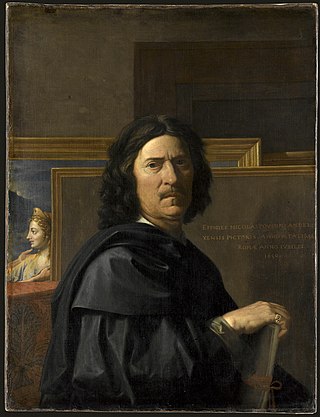
Nicolas Poussin was a French painter who was a leading painter of the classical French Baroque style, although he spent most of his working life in Rome. Most of his works were on religious and mythological subjects painted for a small group of Italian and French collectors. He returned to Paris for a brief period to serve as First Painter to the King under Louis XIII and Cardinal Richelieu, but soon returned to Rome and resumed his more traditional themes. In his later years he gave growing prominence to the landscape in his paintings. His work is characterized by clarity, logic, and order, and favors line over color. Until the 20th century he remained a major inspiration for such classically-oriented artists as Jacques-Louis David, Jean-Auguste-Dominique Ingres and Paul Cézanne.
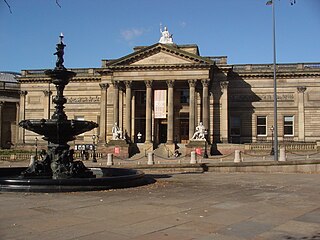
The Walker Art Gallery is an art gallery in Liverpool, which houses one of the largest art collections in England outside London. It is part of the National Museums Liverpool group.
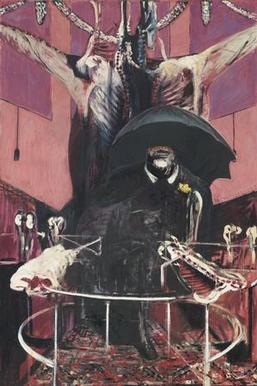
Painting 1946, also known as Painting or Painting (1946), is an oil-on-linen painting by the Irish-born artist Francis Bacon. It was originally intended to depict a chimpanzee in long grass ; Bacon then attempted to paint a bird of prey landing in a field. Bacon described the work as his most unconscious, the figurations forming without his intention.

Cassiano dal Pozzo was an Italian scholar and patron of arts. The secretary of Cardinal Francesco Barberini, he was an antiquary in the classicizing circle of Rome, and a long-term friend and patron of Nicolas Poussin, whom he supported from his earliest arrival in Rome: Poussin in a letter declared that he was "a disciple of the house and the museum of cavaliere dal Pozzo." A doctor with interests in the proto-science of alchemy, a correspondent of major figures like Galileo, a collector of books and master drawings, dal Pozzo was a node in the network of European scientific figures.
Events from the year 1634 in art.
David Freedberg is Pierre Matisse Professor of the History of Art and Director of the Italian Academy for Advanced Studies in America at Columbia University. He was also Director of the Warburg Institute at the University of London from July 2015 to April 2017.

The National Gallery is the primary British national public art gallery, sited on Trafalgar Square, in central London. It is home to one of the world's greatest collections of Western European paintings. Founded in 1824, from an initial purchase of 36 paintings by the British Government, its collections have since grown to about 2,300 paintings by roughly 750 artists dating from the mid-13th century to 1900, most of which are on display. This page lists some of the highlights of the collection.

The Seven Sacraments refers to two series of paintings of the seven sacraments by the French painter Nicolas Poussin.

The Adoration of the Kings is a large oil-on-oak painting by Jan Gossaert, dated to 1510–15, depicting the Adoration of the Magi. Although Gossaert's name is signed on the border of Balthazar's richly embroidered headdress, and on a collar worn by Balthazar's turbaned attendant, the painting was occasionally attributed to Albrecht Dürer in the 17th and 18th centuries. In 2010, Ainsworth suggested that the work was a collaboration between Gossaert and Gerard David.

The Crossing of the Red Sea is a painting by Nicolas Poussin, produced between 1633 and 1634. It depicts the crossing of the Red Sea by the Israelites, from chapter 14 of the book of Exodus. It was made as part of a pair of paintings commissioned by Amadeo dal Pozzo, Marchese di Voghera of Turin, a cousin to Cassiano dal Pozzo, Poussin's main sponsor in Rome. By 1685 the pair had passed to the Chevalier de Lorraine and in 1710 they were bought by Benigne de Ragois de Bretonvillers.

The Adoration of the Shepherds by the Le Nain Brothers is in the National Gallery in London. The painting dates from about 1640, and is relatively unusual as a religious subject or history painting in their oeuvre; they are best known for genre painting, especially groups of peasants. As with most of the works of Antoine, Louis and Mathieu (1607–1677) Le Nain, it is not possible to establish which brother, or combination of brothers, painted it. This painting is unsigned, but when they signed their works, from 1641 to 1648, it was simply as Lenain.

Extreme Unction is one of a set of seven scenes representing the sacraments of the Catholic Church, painted between 1638 and 1640 by the French artist Nicolas Poussin (1594–1665).

The Adoration of the Shepherds is a painting of 1633–34 by the French painter Nicolas Poussin (1594–1665), now in the National Gallery, London. It is in oils on canvas, and measures 97.2 by 74 centimetres. Unusually for Poussin, it is signed "N. Pusin.fe" ["fecit"] on the stone at lower right. By 1637, soon after it was painted, it was owned by Cardinal Gian Carlo de' Medici (1611–1663), the second son of Grand Duke Cosimo II of Tuscany and was placed in his villa outside Florence.

The Martyrdom of Saint Erasmus is an altarpiece, painted by Nicolas Poussin in 1628–1629, originally displayed in St. Peter's Basilica, Rome.

The Battle between the Israelites and the Amorites, Joshua's Battle Against the Amorites or Joshua's Victory over the Amorites is a c. 1625 oil-on-canvas painting by the French artist Nicolas Poussin, now in the Pushkin Museum, in Moscow.
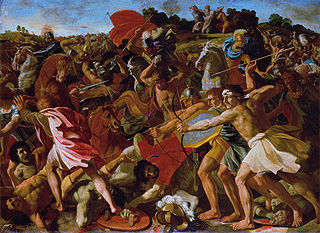
Joshua's Battle Against the Amalekites or Joshua's Victory over the Amalekites is a c. 1625 oil-on-canvas painting by the French artist Nicolas Poussin, now in the Hermitage Museum in Saint Petersburg.
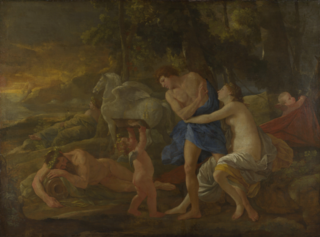
Cephalus and Aurora is the title of two oil paintings by Nicolas Poussin, both dated to about 1629 or 1630. The first is in the National Gallery, London; the second belongs to the Worsley baronets, of Hovingham Hall, Yorkshire.
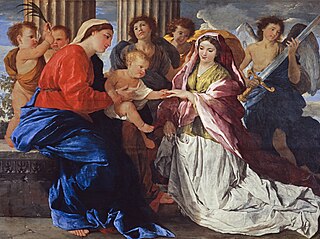
The Mystic Marriage of Saint Catherine is an oil on panel painting by Nicolas Poussin, dated to about 1628–1629, which depicts the mystical marriage of Saint Catherine to Christ. The picture is now in the Scottish National Gallery, Edinburgh.

















